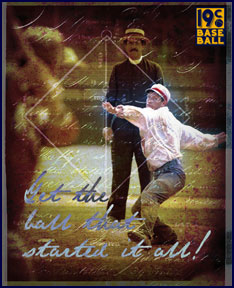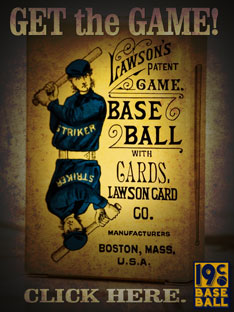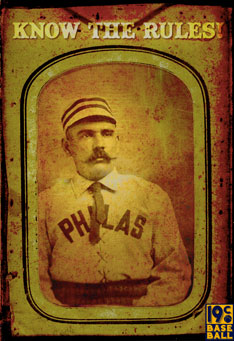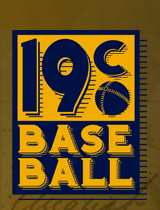Night Baseball in the
19th Century
By Eric Miklich
ooking further into an accidental incident in 1780, Italian scientist Alessandro Volta, in 1792, discovered that two different metals separated by moisture generated electricity. By 1800, Volta proved that this same example produced electricity and enabled him to invent the first electrical battery. Volta helped prove that electricity could move from one place to another via a wire.
The electrical carbon arc light was shown in experimental form by Sir Humphry Davey in 1808. Two carbon rods in a circuit were brought together and an arc was created giving off bright incandescence. The "light" is maintained as long as the rods are very slightly separated and mechanically fed. To provide current for his demonstration, Davey used a large battery.
This same principle was used to provide the light for the first baseball game played at night in 1880. The Northern Electric Company of Boston provided the lighting for two department store teams to play baseball on Nantasket Beach on the back lawn of the Sea Foam House in Hull, Massachusetts. The three 100 foot high towers used were stationed 500 feet apart and were made of wood. The game was played on a Thursday night in early September and the game was terminated after nine innings so the teams could make the last boat back to Boston. The Boston Post gave their endorsement, The Boston Transcript reported that the light was not sufficient and The Boston Daily Globe called the experiment a failure.
The following description of the first night game of baseball was taken from Baseball 1845–1881, by Preston B. Orem.
The First Night Baseball Game,
September 2, 1880With the invention of the electrical light and carbon arc lamps of considerable power, the promoters of these contrivances cast their eyes upon baseball. Why not play it at night?
So the Boston press was invited to Nantasket Beach, Massachusetts to see the first trial on September 2, 1880.
Three Hundred thronged the balconies of the Sea Foam House on Strawberry Hill. 36 carbon lamps had been placed in communication with a dynamo-electric generator, operated by a 30 horse power engine. To support the lamps three towers, 100 feet high and 500 feet apart, were placed so as to overlook a triangle spot just beneath the northern piazzas of Sea Foam House. The lamps were disposed twelve in a group, the total illuminating power being announced as 90,000 candles, or 30,000 candles for each tower.
The flood of mellow light, thrown upon the field between 8 and 9:30 p.m., allowed nine innings to be played. Employee teams of the business firms Jordan, Marsh & Co., and R. H. White & Co., played a tie game, 16 to 16. The light was quite imperfect and there were lots of errors made. The players had to bat and throw with caution. For the spectators the game had little interest as only the movements of the pitcher, in general, could be discerned, while the course of the ball eluded the vision of the watchers.
The showing was far from impressive. None of the reporters believed the idea to be at all practical.
Other night games occurred during the 19th century. On June 2, 1883, the Jenney Electric Light Company, owned by Charles Jenney, illuminated League Park in Fort Wayne, Indiana. Seventeen very large arc lamps providing 4,000 candlepower each. Three lamps were fastened to the grandstand; one was placed behind the pitcher's box and the rest were stationed along the baselines and in the outfield. The seven inning game was played between professionals of the Northwestern League from Quincy, Illinois and a team from Methodist College. The professionals won 19-11. The event was covered by the media and three periodicals, The Gazette, The Fort Wayne News and The Sporting Life were all very critical of the artificial light. The Sporting Life did end their article by stating that with more lights that such an event could be a success.
On August 21st and September 6th, 1888, Tinker Park in Indianapolis held games under artificial light. On the 21st, the Northwestern League's Hoosiers of Indianapolis played a local college club. Natural-gas lights were used for that match. An Atlantic Association exhibition game between Hartford and Baltimore was played at the Ward Street Grounds in Hartford on July 23rd, 1890. An estimated 3,000 spectators paid 25 cents and it is believed that Hartford won 20-19. Twickerham Grounds in Seattle, Washington made an attempt at night baseball on September 6, 1891 and Athletic Park in Los Angeles, California was lit on July 2, 1893.
On July 6th, 1894, an exhibition night game between the Nashville Tigers and the New Orleans Pelicans, both of the Southern League, was played at Athletic Park in Nashville. It was the third game of the day between the two teams and each had recoded a win earlier in the day. According to reports there were 54 large electric lights scattered around the ballpark and a ball covered in phosphours was used. Admission fees for the match were 50 cents for adults and 25 cents for children. The 8:30 PM event attracted an estimated 4,000 spectators. Nashville won by a score of 3-2.
Union Street Ground in Wilmington, Delaware attempted a tripleheader on July 4, 1896. Arc lights were installed at the field and the first two games were played by daylight. The third game, under the lights, turned out to be a disaster. Only about 200 spectators turned out for the event which was hard to view as the outfielders were in shadows and the ball constantly became lost.
In 1897, two more attempts were made in Texas. June 30th at Beach Park in Galveston and July 16th at Clyde Park in San Antonio.




